IBM BladeCenter Chassis User Manual
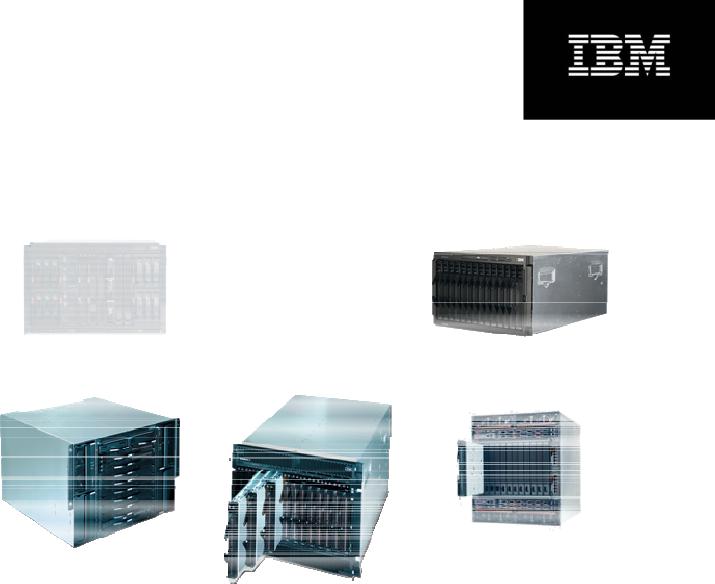
IBM BladeCenter S |
IBM BladeCenter E |
Distributed, small office, |
Best energy efficiency, |
easy to configure |
best density |
IBM BladeCenter T |
IBM BladeCenter H |
IBM BladeCenter HT |
Ruggedized |
High performance |
Ruggedized, |
|
|
high performance |
IBM BladeCenter Chassis
Product Guide
September 2008
Table of Contents
Overview |
3 |
BladeCenter Chassis Positioning |
4 |
IBM BladeCenter Chassis |
6 |
BladeCenter I/O Modules |
30 |
Rack vs. Blades Positioning |
33 |
Citrix Solution |
37 |
Virtualization Solution |
38 |
Please see the Legal Information section for important notices and information. |
2. |
Overview
You need to make IT decisions that will drive business success. You face management challenges and technological complexity such as space constraints, power and cooling limitations, heterogeneous environments and I/O connectivity issues. IBM brings together the widest choice of compatible chassis, blade servers, storage and networking offerings and solution providers in the industry to help you build an open and flexible IT environment. And regardless of the size of your business, you want to be up and running 24/7. With built-in redundancy, innovative power and cooling and the latest I/O and management tools, IBM BladeCenter is easy to own—so you can focus on your business demands and stay ahead of the competition.
The RIGHT choice, tailored to fit your diverse needs.
•It’s flexible and modular. As needs evolve, a one-size-fits-all solution doesn’t work.
–Meet your needs with BladeCenter: everything from a high-performance data center to a small office with limited IT skills—IBM has you covered
–Get flexibility with 5 compatible chassis and 5 blade types supporting multiple I/O fabrics, all managed from a common point
•It’s robust and reliable, providing redundancy throughout and the information you need to keep your business up and running.
–Provide redundancy for no single point of failure with IBM BladeCenter
–Preserve application uptime with IBM Predictive Failure Analysis® and light path diagnostics
–Make decisions based on accurate data for quick problem diagnosis with First Failure Data Capture
OPEN and innovative, for a flexible business foundation.
•It’s comprehensive, providing broad, fast, and reliable networking and storage I/O with BladeCenter Open Fabric.
–Match your data center needs and the appropriate interconnect using a common management point, and 5 I/O fabrics to choose from
–Extract the most from your third-party management solutions by utilizing the BladeCenter Open Fabric Manager
•It’s collaborative, enabling you to harness the power of the industry to deliver innovation that matters.
–Get flexibility from a myriad of solutions created by Blade.org members and industry leaders that have downloaded our open specification
EASY to deploy, integrate and manage.
•It enables efficient integrated management, which allows you to minimize costs with the tools you need for effective management.
–Automate OS installation and BIOS updates remotely with IBM Director tools
–Administer your blades at the chassis or rack level with the Advanced Management Module
–Plug into your enterprise management software
•It enable deployment simplicity without tradeoffs by speeding the deployment of new hardware in minutes rather than days, using BladeCenter Open Fabric Manager
–Get significantly faster deployment of servers and I/O than from rack solutions
–Reduce costly downtime with integrated failover capability
–Manage from a single point of control via the Advanced Management Module
–Use with virtually all IBM switches, blades and chassis
GREEN today for a better tomorrow.
•It offers control via powerful tools that help you optimize your data center infrastructure so you can be responsive.
–Understand your power requirements with IBM Power Configurator
–Monitor, control and virtualize your power with IBM Systems Director Active Energy Manager for x86
–Reduce data center hot spots with the IBM Rear Door Heat eXchanger
–Optimize and future-proof your data center with IBM Data Center Energy Efficiency services
•Our eco-friendly servers and services can help you be environmentally responsible.
–Become more energy efficient with IBM expertise
Please see the Legal Information section for important notices and information. |
3. |
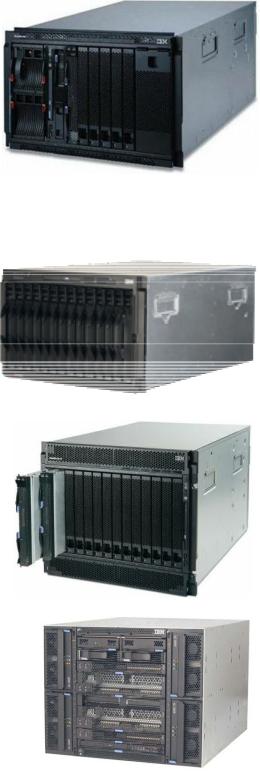
BladeCenter Chassis Positioning
Which BladeCenter Chassis is Right for You?
IBM offers five different BladeCenter chassis built across a consistent architecture. The chassis are targeted to meet your unique requirements, yet all encompass the same commitment to excellence. Remember, BladeCenter blades and switches can be seamlessly moved between chassis. This offers investment protection and incredibly flexible, mix-and- match deployment choices.
IBM BladeCenter S
BladeCenter S is the chassis designed specifically for the mid-market such as small offices, and remote branch locations.. Features include:
•Configurable “business in a box” foundation combines sharable integrated storage with blades and switches
•Comes standard with the BladeCenter Start Now Advisor, which enables easy set up , with “select and click” configurability
•Up to 6 blades, 7U design (convertible to floor-standing configuration using the BladeCenter Office Enablement Kit)
•Up to 12 SAS and/or SATA 3.5-inch HDDs, for an all-in-one chassis containing up to 3.6TB of SAS or 12TB of SATA enterprise-class storage
•Auto sensing 110V or 220V power
•Lowest IT staff requirements
•Lowest total power consumed
•Lowest total heat output
IBM BladeCenter E
BladeCenter E is the core chassis, perfect for mainstream applications, SMBs, data centers and remote sites.
•Up to 14 blades, 7U design
•Highest rack density
•Best energy efficiency per blade
•Best heat efficiency per blade
•Low airflow requirement
•Supports 10Gb Ethernet uplinks and 4Gb Fibre Channel
•Planned availability through 2011
IBM BladeCenter H
BladeCenter H is right for clients looking for next-generation, high-speed I/O— whether InfiniBand™, Fibre Channel or 10Gb Ethernet
•Up to 14 blades, 9U design
•Highest available I/O performance
•Greatest I/O flexibility with up to 8 switch bays
•Hardware-based I/O virtualization
•Supports 30mm blades with up to 8 I/O ports
•Supports 10Gb Ethernet and 4X InfiniBand
•Planned availability through 2011
IBM BladeCenter T
BladeCenter T is a NEBS 3-compliant, ruggedized chassis ideal for telecom, military and medical-imaging applications.
•Up to 8 blades, 8U design
•Non-traditional enviroment support—NEBS 3/ETSI
•Ruggedized chassis
•AC and DC power input
•Planned availability through 2011
Please see the Legal Information section for important notices and information. |
4. |
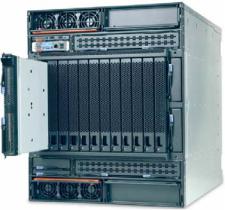
IBM BladeCenter HT
BladeCenter HT is a new telecommunications-optimized version of IBM BladeCenter H. It delivers outstanding core network performance and high-speed connectivity.
•Up to 12 blades, 12U design
•Non-traditional environment support—NEBS 3/ETSI (planned)
•Greatest I/O flexibility with up to 8 switch bays
•Supports 30mm blades with up to 8 ports
•Supports 10Gb Ethernet and 4X InfiniBand
•Ruggedized chassis
•AC and DC power input
•Planned availability through 2011
Compare all this flexibility to what HP has to offer:
Customer Need |
IBM Answer |
HP Answer |
Small office or remote location: |
BladeCenter S |
BladeSystem c-Class 3000 |
High-efficiency data center: |
BladeCenter E |
BladeSystem c-Class 7000 |
Maximum system density: |
BladeCenter E |
BladeSystem c-Class 7000 |
Maximum application performance: |
BladeCenter H |
BladeSystem c-Class 7000 |
Ruggedized: |
BladeCenter T |
NA |
Telecom NGN: |
BladeCenter HT |
NA |
Back-end database: |
System x3850 M2/x3950 M2 |
BladeSystem c-Class 7000 |
Please see the Legal Information section for important notices and information. |
5. |

IBM BladeCenter Chassis
Product Overview
CONTENTS
Product Overview |
6 |
Selling Features |
7 |
Key Features |
15 |
Key Options |
16 |
BladeCenter S Images |
18 |
BladeCenter S Specs |
19 |
BladeCenter E Images |
20 |
BladeCenter E Specs |
20 |
BladeCenter H Images |
21 |
BladeCenter H Specs |
22 |
BladeCenter T Images |
23 |
BladeCenter T Specs |
23 |
BladeCenter HT Images |
25 |
BladeCenter HT Specs |
25 |
Side-by-Side Comparison |
26 |
Chassis/Module/Blade |
|
Compatibility |
28 |
I/O Module Compatibility |
28 |
Today’s data center environment is tougher than ever. You are looking to reduce IT cost, complexity, space requirements, power consumption and heat output, while increasing flexibility, utilization and manageability. Moving to innovative IBM® BladeCenter® as your IT foundation can help you accomplish all of these goals.
The IBM BladeCenter family tightly integrates servers, storage, networking, I/O and applications, allowing you to build a flexible IT infrastructure that is robust, integrated and virtualized using common building blocks. This modular technology integrates Intel® and AMD®, as well as IBM POWER™ or Cell Broadband Engine™ (Cell/B.E.) processorbased blade servers, supporting many operating systems.
All BladeCenter chassis offer impressive features and an extreme degree of compatibility with one another. For example, a single BladeCenter E or BladeCenter H chassis supports up to 14 hot-swappable 30mm-wide blade servers in only 7U (BladeCenter E) or 9U (BladeCenter H) of rack space, up to 8 hot-swappable blades in the rugged 8U BladeCenter T chassis, or up to 12 in the 12U BladeCenter HT high-speed telecommunications chassis. In addition to the blade servers, these chassis also hold up to 4 switches (BladeCenter E/BladeCenter T), up to 10 switches/bridges (BladeCenter H), or 8 switches/bridges (BladeCenter HT) internally. The BladeCenter S, designed for SMB and mid-market customers, takes integration to a new level, combining up to 12 hotswap SAS/SATA HDDs with 6 blade servers and 4 switches. Using a BladeCenter E chassis, up to 84 blade servers (168 processors with multiple cores per processor) can be installed in one industry-standard 42U rack.
Not only can this degree of integration save significant data center space (and therefore the cost of floor space and rack hardware) compared to 1U servers, but consolidating switches/bridges and cables reduces complexity and helps lower cabling costs, and it allows clients to manage everything in the solution as one. But the value of BladeCenter extends far beyond high-density data center environments. For small and medium businesses, as well as remote branch offices with significant computing needs, the compact 7U BladeCenter S houses up to 6 30mm blades, along with 12 3.5-inch hotswap SAS or SATA HDDs, and 4 switches in one chassis. And the setup wizard; BladeCenter Start Now Advisor makes it extremely easy to get started.
The various BladeCenter chassis are designed to monitor environmental conditions in the chassis and each blade and send alerts to the administrator. Advanced standard features help maintain system availability with increased uptime. These features include
Predictive Failure Analysis™, light path diagnostics, hot-swap redundant power supplies and blower/fan modules with Calibrated Vectored Cooling™; IPMI 2.0 support with highly secure remote power control; text-console redirect over LAN, and an Advanced Management Module (upgradeable with a redundant AMM).
If you need a highly manageable, power-efficient, highly compatible family of blade enclosures, BladeCenter is the ideal choice.
Please see the Legal Information section for important notices and information. |
6. |

Selling Features |
Price/Performance |
|
|
• |
The extremely high degree of integration in the various BladeCenter chassis reduces |
|
|
the need for server components, replacing numerous fans, KVM and Ethernet cables, |
|
|
power supplies, external switches and other components with fewer shared hot- |
|
|
swap/redundant components in the BladeCenter chassis themselves. This integration also |
|
|
can greatly reduce the amount of power consumed and heat produced, relative to an |
|
|
equivalent number of 1U servers—or competitive bade systems. This can significantly |
|
|
reduce a data center power bill. The reduced datacenter footprint can also save on |
|
|
infrastructure cost. |
|
• |
BladeCenter Virtual Fabric delivers a flexible, open, connected infrastructure to help |
|
|
optimize application performance. BladeCenter supports many different fabrics, including |
|
|
Ethernet, Fibre Channel, InfiniBand, iSCSI, and a new SAS fabric, providing an easy |
|
|
transition to diskless, stateless servers. This helps centralize storage, offering boot |
|
|
capability, which can dramatically reduce the likelihood of a disk outage. Dual SATA- |
|
|
attached solid state drives can greatly improve drive availability. |
|
• |
Blade servers communicate directly to switch modules inside the BladeCenter |
|
|
Virtual Fabric via redundant Ethernet links to help increase the speed and efficiency |
|
|
of data transfers across blade servers and networks. In addition, the midplanes used |
|
|
in all chassis provide high-speed blade-to-blade (via high-availability firmware) and |
|
|
module-to-module communications internally as well as externally. The midplane used |
|
|
in the BladeCenter H and HT provides four 10Gb data channels to each blade, and |
|
|
supports 4X InfiniBand (HT only) and 10Gb Ethernet high-speed switch modules. |
|
• |
IBM Cool Blue technology’s web-based Power Configurator accurately predicts the |
|
|
power and cooling required for specific configurations, thereby enabling realistic planning |
|
|
of the correct power and cooling infrastructure. The IBM Systems Director Active |
|
|
Energy Manager for x86 (formerly known as PowerExecutive) tool tracks actual power |
|
|
usage, temperatures and heat emitted, and plots trends over time so you can actively |
|
|
manage power and cooling with real information. Active Energy Manager also will manage |
|
|
through power incidents (e.g., brownouts or supply failures.) to help users avoid outages |
|
|
due to power and cooling issues. IBM’s Rear Door Heat Exchanger can help address hot |
|
|
spots in the data center. Cool Blue’s Active Energy Manager also provides an industry- |
|
|
unique capability to virtualize power (capping) and move it from one server to another, as |
|
|
required. This capability helps maximize server usage within a restricted power envelope. |
|
• |
The IBM BladeCenter family features the industry’s most energy-efficient design. The |
|
|
various BladeCenter chassis use ultrahigh efficiency power supplies. Most industry- |
|
|
standard servers use power supplies that are between 65-75% efficient at converting |
|
|
power from AC wall current to the DC power used inside servers. BladeCenter power |
|
|
modules are up to 91% efficient. This helps save even more money, as more of the |
|
|
power input you are paying for is used for processing, rather than released into the data |
|
|
center as waste heat. |
|
• |
BladeCenter also reduces the number of parts required to run the system. Sharing |
|
|
fans, systems management, floppy devices and media means fewer parts to buy and |
|
|
maintain, and fewer items that can fail and bring the solution down. |
|
|
|
Flexibility/Durability
•Every HS/LS/JS blade server ever released by IBM is supported in BladeCenter H and BladeCenter HT, and most are supported in every BladeCenter chassis ever released, going back to 2002. Every switch module released by IBM is equally compatible. (Ask HP and Dell how far back their compatibility goes.) Future blades and fabric switches are expected to continue to be compatible with previous chassis for the foreseeable future.
•The optional Multi-Switch Interconnect Module (MSIM) installs in a high-speed switch module bay of a BladeCenter H chassis and doubles the number of Gigabit Ethernet and Fibre Channel connections to every blade in the chassis (up to 8 or 12 ports, depending on the switch).
•A blade server has access to as many as 10 communication switches/bridges in a BladeCenter H or 8 in a BladeCenter HT chassis. (Up to 4 switches in a BladeCenter or BladeCenter T chassis.) And the switches can be Ethernet, InfiniBand, Fibre Channel, Myrinet, or anything else designed and ServerProven for BladeCenter use. Switches,
bridges and interface cards are currently available from such vendors as Brocade, Cisco, Intel®, Nortel/Blade Network Technologies, QLogic, Cisco and others, in addition to IBM.
•Nearly 100 vendors are offering options for the BladeCenter family.
Manageability
•IBM System Director provides powerful, intelligent solutions management for the BladeCenter family, for rock-solid reliability. System Director exploits the hardware’s
Please see the Legal Information section for important notices and information. |
7. |

capabilities by “surfacing” pertinent information about your blade server. The easy-to-use Deployment Wizard also provides step-by-step installation instructions and offers automated deployment capabilities.
•Each BladeCenter chassis includes an Advanced Management Module (AMM). The AMM boosts administrator productivity and reduces skill level requirements, which can help reduce costs, improve overall productivity and make administration easier. Unlike traditional servers and some competitive blades with a myriad of separate management tools, this management module provides a single point of control for the solution and supports many industry-standard, open protocols. The AMM provides systems management capabilities, including Web-based out-of-band control; virtual floppy and CDROM support; Windows “blue screen” error capture; LDAP and SSL support; and remote redirection of video, text, keyboard and mouse for the chassis and the components installed in the chassis.
•IBM Systems Director Active Energy Manager for x86, an IBM-exclusive, is designed to take advantage of new system power management features, by monitoring actual power usage and providing power consumption capping features. More accurate power usage data helps with data center construction planning and the sizing of power and cooling needs, as well as allowing you to use available power more efficiently.
•IBM System Director is included for proactive systems management and works with both the blade’s internal BMC and the chassis’ management module. It comes with a portfolio of tools, including IBM Systems Director Active Energy Manager for x86, Management Processor Assistant, RAID Manager, Update Assistant, and Software Distribution. In addition, IBM System Director offers extended systems management tools for additional server management and increased availability. When a problem is encountered, IBM System Director can issue administrator alerts via e-mail, pager, and other methods.
•BladeCenter provides real-time hardware event monitoring with IBM Service Manager. Service Manager simplifies operations for remote branch users and beginner BladeCenter users by automating notification of service and support so that users will be contacted with resolutions to problems when they occur.
Availability and Serviceability
•BladeCenter chassis are designed for operation with greatly reduced potential for single points of failure. Most aspects of operation, from blade servers to communication modules, to management modules, to power and blower/fan modules, are hotswappable and redundant. The midplane connections are redundant and other features can be made so, when used in pairs.
•Environmentally tuned blower/fan modules in the chassis adjust to compensate for changing thermal characteristics. At the lower speeds they draw less power and suffer less wear. Equally important in a crowded data center, temperature-controlled blowers/fans produce less ambient noise in the data center than if they were constantly running at full speed.
•A standard three-year (parts and labor) limited onsite warranty1 affords you peace of mind and greater potential investment protection.
BladeCenter Chassis
IBM’s blade architecture offers five choices of chassis in which to use various blade servers. Each chassis serves different customer needs. The new BladeCenter S is a small, entry-level chassis that offers compatibility and interoperability with the other chassis. The original BladeCenter E chassis offers maximum density, great flexibility and a wide variety of expansion options at an entry-level price. The next-generation BladeCenter H chassis offers all of BladeCenter’s capabilities, and adds new highperformance features. If you need a ruggedized chassis (for example, government/military or telcos), BladeCenter T offers special features optimized for those environments. The next-generation BladeCenter HT is a high-performance ruggedized telecommunications platform. There is a high degree of interchangeability and compatibility of features among the chassis. Any or all of these chassis can be installed in
arack along with other rack-optimized equipment.
1For terms and conditions or copies of the IBM Statement of Limited Warranty, call 800-772-2227 in the U.S. In Canada call 800-426-2255. Telephone support may be subject to additional charges. For warranties including onsite labor, a technician is sent after IBM attempts to resolve the problem remotely. International warranty service is available in any country in which this product is sold.
Please see the Legal Information section for important notices and information. |
8. |
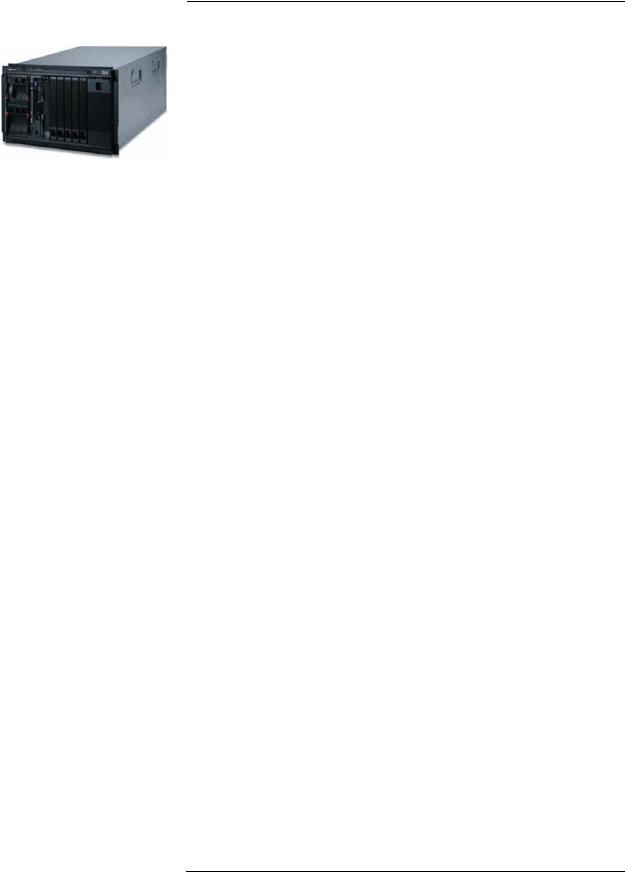
BladeCenter S provides:
•A choice of installation methods — Designed for either rack or deskside use with the optional Office Enablement Kit, it’s ideal for offices or remote/branch locations.
•Integrated compute blades, SAN storage, and switches in one chassis — In addition to six blade servers, the BladeCenter S also supports 12 shared hot-swap 3.5-inch SAS, SATA, or Nearline SAS HDDs, and four integrated switches (two Ethernet, plus two Ethernet, Fibre Channel, SAS, or RAID SAS Controllers, which can enable true shared storage).
•Six 30mm blade slots — These hot-swap slots are capable of supporting any
combination of 6 HC10/HS12/HS20/HS21/HS21 XM (Intel Xeon), LS20/LS21/LS22 (AMD Opteron®), and JS12/JS21/JS22 (IBM PowerPC® 970FX/MP) blade servers, or 3 doublewide (60mm) LS41/LS42 blade servers or a mixture of 30mm and 60mm blades. It also supports multiple optional 30mm Expansion Units in combination with the blade servers, using the same blade slots. Up to six chassis can be installed in an industry-standard 42U rack, for a total of up to 36 30mm blade servers and 72 HDDs per rack, plus switches, with full power redundancy.
•Standard office 110V power or 220V power — Don’t have a data center, but still want to consolidate many servers into a few? No problem. BladeCenter S runs on standard office power (as well as 220V), using an auto-sensing power supply.
•Simplified setup and configuration — BladeCenter S’s configurable “business in a box” foundation offers the BladeCenter Start Now Advisor, a wizard-based installation tool on a DVD that is shipped standard with every chassis. You can be up and running in minutes. A user can literally plug the blade servers into the system, plug the system into a power outlet, and launch a management tool that enables easy select-and-click configuration via an "express" install. For businesses operating branch offices—such as retailers or financial institutions—IT administrators at headquarters can easily pre-configure hundreds of blade systems to operate in the same manner and ship them out the door knowing an office employee will be able to simply plug a system in and power it up.
•Forward and backward compatibility — Most blades, and every switch and passthru module released by IBM for BladeCenter E since 2002, are supported. Many new blades and 1X fabric switches released for IBM BladeCenter E, BladeCenter H, BladeCenter T, or BladeCenter HT are also supported in the BladeCenter S chassis.
•One module bay for hot-swap Advanced Management Module — The management module provides advanced systems management and KVM capabilities for not only the chassis itself, but for all of the blades and other modules installed in the chassis. The
management module provides capabilities similar to the IBM Remote Supervisor Adapter II used in stand-alone IBM System x™ or IBM eServer™ xSeries® rack and tower servers. The features of the management module can be accessed either locally or remotely across a network. One module comes standard.
•One module bay for hot-swap Serial Passthru Module — This module provides six RJ45 serial ports (one per blade). The ports are numbered 1 through 6, and correspond to blade slots 1 through six.
•Two bays for hot-swap Storage Modules — Each module supports up to 6 hot-swap SAS, SATA, or Nearline SAS drives (12 total), for an internal capacity of up to 3.6TB (using 300GB SAS HDDs) or 12TB (using 1TB SATA drives). The drives can be mixed within a Storage Module. The drives can be shared by one or more blades. If any drives are installed, one or two (for redundancy) SAS Connectivity Modules or the SAS RAID Controller Modules must be installed in switch bays 3 and/or 4. (In addition, if you have
BladeCenter Storage and I/O Expansion Unit blades, which attach to the HS and LS blades, these are supported as well.)
•Four module bays for hot-swap communication and I/O switches — The modules interface with all of the blade servers in the chassis and eliminate the need for external switches or expensive, cumbersome, and error-prone cabling. All connections are done internally via the midplane. All modules, when installed in pairs, offer load balancing and failover support. Integrated switch modules mean that no extra “U space” is required in the rack. The first two bays support Ethernet switches only (one comes standard). The other two bays support Ethernet, Fibre Channel, or SAS switches. Either one or two of a kind is required in Bays 3 and 4. (No mixing and matching between the pair.)
•Four module bays for Fan Modules — Four hot-swap/redundant blower modules come standard with the chassis. (Each module contains two fans.) They are capable of providing efficient cooling for all blades, switches and storage devices. These modules replace the need for each blade to contain its own fans. The four fan modules are more energy efficient than dozens or hundreds of smaller fans would be, and they offer many fewer points of potential failure.
•Four module bays for hot-swap Power Modules — BladeCenter S ships with two 950W
Please see the Legal Information section for important notices and information. |
9. |

/ 1400W high-efficiency hot-swap/redundant power modules (upgradeable to four), capable of handling the power needs of the entire chassis. Many servers use power supplies with an efficiency level of approximately 65-75%. Because BladeCenter S uses power supplies that are at least 90% efficient, much less power is wasted as heat. Not only is more power available for chassis use, there is less power wasted as excess heat output. Two additional power modules must be installed when the second Storage Module is used.
•Redundant midplane connections — Each chassis contains a midplane that connects all blades and modules together internally. The midplane provides two physical connections to each blade; therefore, a failure of one connector alone cannot bring down the server.
•A hot-swappable Media Tray containing a DVD-RW/CD-RW drive, two USB 2.0 port, two BBU module bays, and a light path diagnostic panel—the media tray is shared by all the blades in the server. This eliminates unnecessary parts (and reduces the number of parts than can fail). In the event of a failure of the Media Tray the tray can be swapped for another. While the tray is offline, the servers in the chassis can remotely access the Media Tray in another chassis. The diagnostic LEDs indicate chassis status.
It is extremely important to include all infrastructure costs when comparing a BladeCenter S solution to a competitor’s offering, not just the cost of the chassis and the blades. The high density and level of integration of the BladeCenter chassis greatly reduces the cost of the overall solution. For example, because up to six chassis will fit in a rack, this means that up to 24 switches can be installed per rack without having to reserve any “U” space for the switches, unlike the competition. (And the integrated switches may be less expensive than external, self-powered switches.) Plus, the number of power distribution units (PDUs) needed per rack may be reduced, because there are fewer discrete devices to have to plug in. In addition, because all the blades are connected to all the switches inside the chassis, there is no need for external Ethernet or other communication cables to connect the blades and switches. (Only the few cables needed to connect the switches to the external world are required.) This not only saves the cost of numerous cables per rack, but also the clutter and bother of routing that many cables. An added bonus is potentially much freer airflow behind the rack, due to fewer cables.
BladeCenter E is a 7U chassis that provides:
•Reduced single points of failure — Many major components (either standard or optionally) are hot-swappable and/or redundant. Servers and modules can be configured for automatic failover to backups.
•Forward and backward compatibility — Most blades, and every switch and passthru module released by IBM for BladeCenter E since 2002, are supported. Many new blades and fabric switches released for IBM BladeCenter H, BladeCenter T, or BladeCenter HT are also supported in the BladeCenter E chassis.
•Fourteen 30mm blade slots — These hot-swap slots are capable of supporting almost any combination of 14 HC10/HS12/HS20/HS21/HS21 XM, LS20/LS21, and
JS12/JS20/JS21, or QS20 (Cell/B.E) blade servers, or 7 double-wide (60mm) HS40 or LS41 blade servers or a mixture of 30mm and 60mm blades. (Note: The QS20 blade cannot be mixed with other blades.) It also supports multiple optional 30mm Expansion Units in combination with the blade servers, using the same blade slots. Up to six chassis can be installed in an industry-standard 42U rack, for a total of up to 84 30mm blade servers per rack, with full power redundancy.
•Four module bays for communication and I/O switches — The modules interface with all of the blade servers in the chassis and eliminate the need for external switches or expensive, cumbersome, and error-prone cabling. All connections are done internally via the midplane. Two module slots are reserved for hot-swap/redundant Gigabit Ethernet switch modules. The other two bays support additional Gigabit Ethernet modules, or Fibre Channel, InfiniBand, and other switch modules or pass-through devices. All modules, when installed in pairs, offer load balancing and failover support. Integrated switch modules mean that no extra “U space” is required in the rack.
•Two module bays for management modules (IBM BladeCenter Management Module or the newer Advanced Management Module, depending on the model of the BladeCenter chassis) — The management module provides advanced systems management and KVM capabilities for not only the chassis itself, but for all of the blades and other modules
installed in the chassis. The management module provides capabilities similar to the IBM Remote Supervisor Adapter II used in stand-alone IBM System x™ or IBM eServer™ xSeries® rack and tower servers. The features of the management module can be accessed either locally or remotely across a network. One module comes standard. A second management module can be added for hot-swap/redundancy and failover.
•Two module bays for Blower Modules — Two hot-swap/redundant blower modules
Please see the Legal Information section for important notices and information. |
10. |
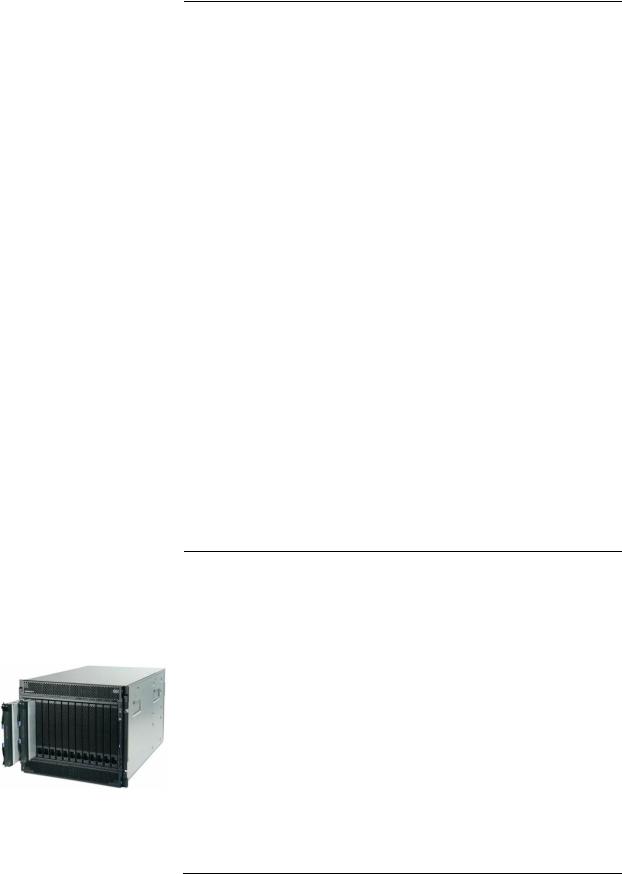
come standard with the chassis. They are capable of providing efficient cooling for up to 14 blades. These modules replace the need for each blade to contain its own fans. The two blowers are more energy efficient than dozens or hundreds of smaller fans would be, and they offer many fewer points of potential failure.
•Four module bays for Power Modules — BladeCenter E ships with two 2000W highefficiency hot-swap/redundant power modules (upgradeable to four), capable of handling the power needs of the entire chassis. Many servers use power supplies with an efficiency level of approximately 65-75%. Because BladeCenter E uses power supplies that are at least 90% efficient, much less power is wasted as heat. Not only is more power available for chassis use, there is less power wasted as excess heat output. Two additional power modules must be installed when more than 6 blades are used in a chassis.
•Redundant midplane connections — Each chassis contains a midplane that connects all blades and modules together internally. The midplane provides two physical connections to each blade; therefore, a failure of one connector alone cannot bring down the server.
•A hot-swappable Media Tray containing a DVD-ROM drive, a floppy drive, one USB 1.1 port, and a light path diagnostic panel — The media tray is shared by all the blades in the server. This eliminates unnecessary parts (and reduces the number of parts than can fail). In the event of a failure of the Media Tray the tray can be swapped for another. While the tray is offline, the servers in the chassis can remotely access the Media Tray in another chassis. The diagnostic panel contains LEDs that indicate chassis status.
•IBM Airborne Contaminant Filter, which helps protect the blade server’s vital components in non-data center environments.
It is extremely important to include all infrastructure costs when comparing a BladeCenter E solution to a competitor’s offering, not just the cost of the chassis and the blades. The high density and level of integration of the BladeCenter chassis greatly reduces the cost of the overall solution. For example, because up to six chassis will fit in a rack, this means that up to 84 blade servers/processors can be installed. (Some competitive blade offerings would require a second rack for this many blades.) Also, because up to four Ethernet, Myrinet, Fibre Channel, InfiniBand or other switches can be installed per chassis, up to 24 switches can be installed per rack without having to reserve any “U” space for the switches, unlike the competition. (And the integrated switches may be less expensive than external, self-powered switches.) Plus, the number of power distribution units (PDUs) needed per rack may be reduced, because there are fewer discrete devices to have to plug in. In addition, because all the blades are connected to all the switches inside the chassis, there is no need for external Ethernet or other communication cables to connect the blades and switches. (Only the few cables needed to connect the switches to the external world are required.) This not only saves the cost of numerous cables per rack, but also the clutter and bother of routing that many cables. An added bonus is potentially much freer airflow behind the rack, due to fewer cables.
BladeCenter H is a high-performance 9U chassis, designed for compute-intensive environments, such as Earth/Life Sciences, commercial analytics and next-generation network (NGN) applications. Think of it as BladeCenter E’s big brother, with more speed and more features. It provides:
•Reduced single points of failure — Many major components (either standard or optionally) are hot-swappable and/or redundant. Servers and modules can be configured for automatic failover to backups.
•Forward and backward compatibility — Every blade, switch, and passthru module released by IBM for the original BladeCenter E chassis since 2002 is supported in the BladeCenter H chassis.
•High-speed redundant midplane connections — Based on 4X InfiniBand, the midplane supports up to 40Gb bandwidth and provides four 10Gb data channels to each blade. By giving each blade two physical connections to the midplane that connects all blades and modules together internally, a failure of one connector alone cannot bring down the server.
•Fourteen 30mm blade slots — These hot-swap slots are capable of supporting any combination of 14 HC10/HS12/HS20/HS21/HS21 XM, LS20/LS21, JS20/JS21/JS22, and
QS21/QS22 (Cell/B.E), or 7 double-wide (60mm) HS40 or LS41 blade servers, or a mixture of 30mm and 60mm blades. It also supports multiple optional 30mm Expansion Units in combination with the blade servers, using the same blade slots. Up to four chassis can be installed in an industry-standard 42U rack, for a total of up to 56 30mm blade servers per rack.
•Up to ten module bays for communication and I/O switches or bridges — The
Please see the Legal Information section for important notices and information. |
11. |

modules interface with all of the blade servers in the chassis and alleviate the need for external switches or expensive, cumbersome, and error-prone cabling. All connections are done internally via the midplane. Two module slots are reserved for hot-swap/redundant Gigabit Ethernet switch modules. Two slots support either high-speed bridge modules or legacy Gigabit Ethernet, Myrinet, Fibre Channel, InfiniBand and other switch modules. Two slots are dedicated for bridge modules. Four additional slots are dedicated for hot-swap/redundant high-speed switch modules. All modules, when in stalled in pairs, offer load balancing and failover support.
•Integrated switch and bridge modules mean that no additional rack “U” space is required.
•Two module bays for Advanced Management Modules — The management modules provide advanced systems management and KVM capabilities for not only the chassis itself, but for all of the blades and other modules installed in the chassis. The Advanced Management Module provides capabilities similar to the IBM Remote Supervisor Adapter II SlimLine used in stand-alone System x rack and tower servers. Features include concurrent KVM (cKVM), an external Serial over LAN connection, industrystandard management interfaces (SMASH/CLP/CIM/HPI), USB virtualization, network failover and backward compatibility with the original Management Module, among others. The features of the module can be accessed either locally or remotely across a network. One module comes standard. A second module can be added for hot-swap/redundancy and failover. The module uses USB ports for keyboard and mouse.
•Two module bays for Blower Modules — Two hot-swap/redundant blower modules come standard with the chassis. They are capable of providing efficient cooling for up to 14 blades. These modules replace the need for each blade and switch to contain its own fans. The blowers are more energy efficient than dozens or hundreds of smaller fans would be, and they offer many fewer points of potential failure. BladeCenter H also includes up to four additional hot-swap/redundant fan packs to cool the power supplies and high-speed switch modules.
•Four bays for Power Modules — BladeCenter H ships with two 2900W high-efficiency hot-swap/redundant power modules (upgradeable to four), capable of handling the power needs of the entire chassis, including future higher-wattage processors. Each power module includes a customer-replaceable hot-swap/redundant fan pack (3 fans) for additional cooling capability.
•A hot-swappable Media Tray containing an optional DVD/CD read only or CVD/CD multi-burner drive, two USB 2.0 ports, and a light path diagnostic panel — The media tray is shared by all the blades in the server. This reduces unnecessary parts (and reduces the number of parts than can fail). In the event of a failure of the Media Tray the tray can be swapped for another. While the tray is offline, the servers in the chassis can remotely access the Media Tray in another chassis. The light path diagnostic panel contains LEDs that indicate chassis status.
•Multi-Switch Interconnect Module (MSIM) — When installed in a BladeCenter H highspeed switch bay, the optional IBM Multi-Switch Interconnect Module (MSIM) doubles the number of ports available to any blade server in the chassis. Depending on the switch, this can mean up to 8 or 12 Gigabit Ethernet or Fibre Channel ports per blade.
•A serial breakout port with optional cable — This provides a direct serial connection to each blade server installed in the chassis, as an alternative to Serial over LAN. (Note: This applies only to newer blades that include this capability.)
•It is extremely important to include all infrastructure costs when comparing a BladeCenter H solution to a competitor’s offering, not just the cost of the chassis and the blades. The high density and level of integration of the BladeCenter H chassis can greatly reduce the cost of the overall solution. For example, because up to four chassis will fit in a rack, this means that up to 56 blade servers can be installed. Also, because up to 10 (1Gb or 10Gb) Ethernet, Myrinet, Fibre Channel, InfiniBand or other bridges and switches can be installed per chassis, up to 40 switches and bridges can be installed per rack without having to reserve any “U” space for the switches, unlike the competition. (And the integrated switches may be less expensive than external, self-powered switches.) Plus, the number of power distribution units (PDUs) needed per rack may be reduced, because there are fewer discrete devices to have to plug in. In addition, because all the blades are connected to all the switches inside the chassis, there is no need for external
Ethernet or other communication cables to connect the blades, bridges and switches. (Only the few cables needed to connect the switches to the external world are required.) This not only saves the cost of numerous cables per rack, but also the clutter and bother of routing that many cables. An added bonus is potentially much freer airflow behind the rack, due to fewer cables.
BladeCenter T is a carrier grade, rugged 8U (20-inch deep) chassis designed for challenging central office and networking environments. It provides:
Please see the Legal Information section for important notices and information. |
12. |
